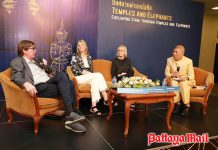If you are British or American, you might be surprised to know that the Baltic States, which lie on the Gulf of Finland, are much further to the east than you might expect. Look at a map of Europe and you’ll see that Estonia, Latvia and Lithuania are stacked on top of each other between Poland and Russia. And here’s the interesting thing; they’re on the same longitude as Serbia, Macedonia and Western Greece. So it’s not particularly surprising that Estonian folk music sits on a kind of musical crossroads between East and West.
Here, hundreds of years ago animistic beliefs met Christianity, and spell-casting songs met Gregorian chant. Surprisingly perhaps, despite the fact that Estonia is rich in music, the western-style culture of classical composing didn’t emerge until the turn of the twentieth century. At that time, most of the Estonian composers and performers were educated at Russia’s St. Petersburg Conservatory.
 Lluís Travesset in 2012.
Lluís Travesset in 2012.
Estonia is roughly the same size as Denmark or the Netherlands but today, it seems to have a disproportionate number of successful composers. Many of them are writing interesting and approachable music but have yet to be invited aboard the competitive and somewhat overcrowded band-wagon of contemporary composers. Arvo Pärt is the most well-known internationally and is probably responsible for putting Estonia on the classical music map.
Arvo Pärt has had a fascinating creative life. In his early days he wrote in an astringent neo-classical style and was influenced by Shostakovich, Prokofiev, and Bartók. Then he ventured into a twelve-tone serial technique but this earned the ire of the old-fashioned Soviet establishment and also proved to be a creative cul-de-sac.
Pärt went through a long period of creative and contemplative silence absorbing himself in plainsong, Gregorian chant and early choral music. Since the late seventies, he has used his self-invented compositional technique known as tintinnabuli a kind of minimalist harmonic style, partly inspired by Gregorian chant. Pärt’s new-found voice couldn’t be more different from his earlier styles but it’s brought him world-wide fame and had an enormous influence on other composers.
Arvo Pärt (b. 1935): Vater Unser (“Our Father”). Lluís Travesset (boy soprano), soloist of the Escolania de Montserrat with org. acc. (Duration: 03:46; Video: 1080p HD)
In the year 1025, the Benedictine community of Santa Maria de Montserrat was founded near Barcelona in Spain. It is thought that sometime in the early fourteenth century, the choir school L’Escolania de Montserrat was established. In modern times the school choir has achieved international recognition and gives daily performances at the Basilica to the delight of large groups of pilgrims and tourists from around the world. The choir is made up of Spanish boy sopranos and altos, augmented when necessary with lower voices.
Composed in 2005, this beautiful and engaging work uses the German text of The Lord’s Prayer. In 2011 the composer dedicated the piece to Pope Benedict XVI who you may recall, was Joseph Ratzinger and pope between 2005 until his resignation in 2013. The work is scored for boy soprano and keyboard and although deceptively simple, gives an insight into Arvo Pärt’s later composing style. It’s surprisingly moving and potent in its simplicity and directness. At the time of the recording, Lluís Travesset was a soloist of the L’Escolania de Montserrat.
Erkki-Sven Tüür (b.1959): Ärkamine (“Awakening”) Estonian Philharmonic Chamber Choir, Sinfonietta Riga cond. Daniel Reuss (Duration: 38:03; Video: 1080p HD)
If your musical taste runs to something a bit meatier, then you could try this powerful and engaging work by the prolific Estonian composer Erkki-Sven Tüür. Don’t let the slightly alien sounds of the opening bars put you off because the work has a great deal to offer.
The composer, who studied flute and percussion at Tallinn Music School, was originally involved in a progressive rock band, and for a time he was the most popular rock musician in Estonia. During the mid-1980s he shifted towards “serious” music and today he’s one of the brightest voices in Estonian classical music with eight symphonies and nine concertos to his credit, together with a wealth of instrumental music.
Erkki-Sven Tüür describes his music as “abstract dramas in sound” which “unfold in a space that is constantly shifting, expanding and contracting.” His music certainly has a sense of expansiveness with a structure that suggests organic growth.
This cantata was commissioned for Tallinn as European Capital of Culture in 2011 and the work intersperses twentieth-century Estonian poetry with Latin texts related to Easter. The work is about the springtime mystery of nature’s rebirth, combining both eastern and western traditions. Its underlying theme is the human yearning for higher spiritual awareness – something which often dominates the music of Arvo Pärt. This is a compelling work in which the choir creates a crystal clear sound by singing with almost no vibrato. It’s a stunningly good performance.




